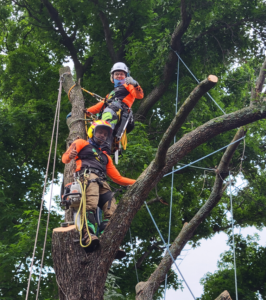Imagine standing in your backyard, gazing up at your majestic oak tree. Its branches stretch toward the sky, a symbol of strength and endurance. But then, a thought creeps in: can trimming this beautiful giant actually harm it? It’s a question that lingers in the minds of homeowners and gardening enthusiasts alike. Let’s delve deep into the world of tree trimming and uncover the truths and myths surrounding this essential practice.
The What: Understanding Tree Trimming
Tree trimming, often referred to as pruning, is the process of selectively removing certain parts of a tree, such as branche and sprouts. The primary goal is to enhance the tree’s health, aesthetic appeal, and safety. While it may seem counterintuitive to cut away parts of a living organism, trimming is often necessary for the overall well-being of the tree.
Why Trim Your Trees?
Here are several reasons why tree trimming is a crucial aspect of tree care:
- Promoting Health: Regular trimming removes dead or diseased branches, preventing the spread of diseases and pests.
- Improving Aesthetics: Trimming shapes the tree, enhancing its appearance and allowing for a more attractive landscape.
- Increasing Safety: Removing low-hanging or weak branches minimizes the risk of falling limbs, especially during storms.
- Encouraging Growth: Pruning stimulates new growth and can lead to a fuller, healthier tree.
- Enhancing Sunlight and Airflow: Trimming allows more sunlight and air to reach the inner branches, promoting better health.
The How: Techniques of Tree Trimming
Understanding the techniques of tree trimming can help prevent potential harm to the tree. Here are some popular methods:
- Crown Thinning: Selectively removing branches to improve light penetration and airflow through the tree’s crown.
- Crown Raising: Removing lower branches to create clearance for pedestrians, vehicles, and buildings.
- Crown Reduction: Reducing the height or spread of the tree’s crown while maintaining its natural shape.
- Deadwooding: Removing dead or dying branches to improve the tree’s appearance and health.
Each method has its benefits and specific applications, and it’s essential to choose the right technique based on the tree’s species and health.
The Where: When and Where to Trim Your Trees
Timing is everything when it comes to tree trimming. The best time to prune most trees is during the late winter or early spring before new growth begins. However, some species have specific timing needs. For example, flowering trees are best pruned right after they bloom.
Signs That Your Tree Needs Trimming:
- Dead or Dying Branches: If you notice branches that are lifeless, it’s time for a trim.
- Overgrown Appearance: When the tree’s branches start crowding each other or other plants, it’s a sign for trimming.
- Increased Pest Activity: If you see more insects or fungi on your tree, it may need some attention.
- Interference with Structures: If branches are getting too close to buildings or power lines, trimming is necessary.
The Myth: Can Trimming a Tree Kill It?
The fear of harming or killing a tree through trimming is prevalent, but the truth is that improper trimming, rather than trimming itself, can lead to issues. Over-pruning, which involves cutting away too many branches or removing large sections, can stress the tree, making it vulnerable to pests and diseases.
A Cautionary Tale
Consider the story of a local homeowner, Sarah, who loved her sprawling Post Oak tree. Eager to improve its appearance, she hired a tree service that advertised low prices but lacked certified arborists. The crew, without any professional knowledge of tree care, deliberately cut away large sections of the tree, removing nearly half of its branches. The tree struggled to recover from the severe pruning and eventually succumbed to a disease that had previously been contained. This heartbreaking story illustrates the importance of choosing a reputable tree service with qualified professionals who understand proper tree trimming techniques and know when to intervene to protect the health of your trees.
FAQ: Your Tree Trimming Questions Answered
Q: How often should I trim my trees?
A: Generally, trees should be trimmed every 1-3 years, depending on their growth rate and health. Regular maintenance helps ensure optimal health and appearance.
Q: Will trimming my tree cause it to grow faster?
A: While trimming does not directly increase the growth rate, it can promote healthier growth by allowing sunlight and air to reach the inner branches.
Q: When is the best time to trim trees?
A: The ideal time for trimming trees is late winter or early spring, just before new growth begins. This timing allows for better healing and reduces the risk of diseases, as the tree is still dormant.
Importance of Professional Tree Trimming
While some homeowners may feel confident trimming their trees themselves, the reality is that tree trimming is an art that requires knowledge, skill, and the right tools. Certified arborists understand the specific needs of different tree species and can assess a tree’s health before deciding on a trimming plan.
Choosing to hire professionals can save you time, money, and stress in the long run. At Lemon Tree, our certified arborist, Cristhian Castaneda, has years of experience and knows how to trim your trees safely and effectively.
What Are Your Tree Trimming Experiences?
Have you ever trimmed your trees? What challenges did you face? Share your experiences in the comments below—we’d love to hear from you!
Connect with Lemon Tree for Professional Tree Pruning
Are you ready to give your trees the care they deserve? Don’t risk harming them with improper trimming techniques. Contact Lemon Tree Tree Service today to schedule a consultation with our certified arborist. Let us help you keep your trees healthy, beautiful, and thriving for years to come!



